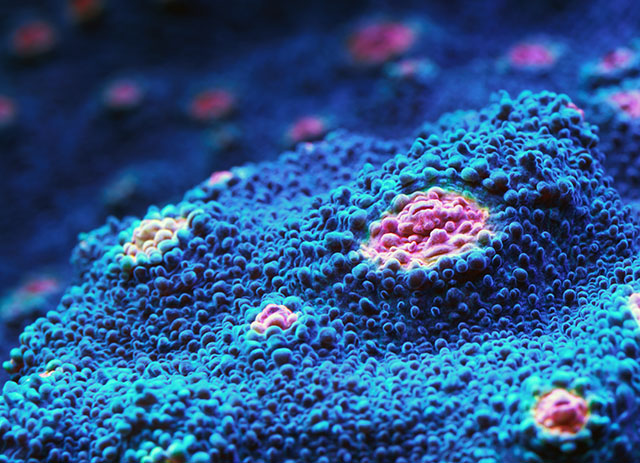4 Reef Tank LED Lighting Kits: Which Is Right For You?
As we move into the new year, it's time to start thinking about what reef tank LED lighting kits will...
Jim Sabellico
March 30, 2023

Corals are not just beautiful creatures that add color to an underwater world, but they also play a vital role in maintaining a healthy marine ecosystem. Among the many types of corals, chalice coral stands out for its unique features and characteristics. I
We’ll explore everything you need to know about chalice coral – from their growth rate to their preferred lighting, and everything in between.
Chalice corals belong to the Pectiniidae family, which includes popular genera such as Oxypora, Mycedium, and Echinophyllia. As the name suggests, chalice corals have plate-like skeletons that look like cups, hence the name chalice.
One of their unique features is their growth rate, which varies depending on the thickness of the skeleton. Corals with thin skeletons grow rapidly, doubling in size every four months. However, those with thicker skeletons take much longer, growing only about a quarter of an inch per month.
When it comes to the appearance of chalice corals, they are usually flat, which is why some reefers call them as plate corals. They come in various colors, such as green, pink, blue, and purple, with intricate patterns and designs on their surface. Some chalice coral species have long tentacles, while others have short ones. Overall, chalice corals are fascinating creatures to observe and admire.
Chalice corals require low to moderate lighting for their growth and health, with the ideal range from 80 to 120 par. If the lighting is too bright, you’ll quickly observe the coral displaying its displeasure by pressing its tissue tightly against the skeleton.
On the other hand, chalices display their best colors under a blue light spectrum. So if you want your chalice coral to flaunt its vibrant hues, you need to provide it with blue lighting.
Water flow is one of the most important factors in Chalice Coral care. Some chalice coral species have a bowl-like structure, making them more susceptible to collecting debris. If the water flow rate in your tank is not high enough, it may lead to stagnant water and debris accumulation around your chalice coral.
On the other hand, if the coral’s tissue is moving too much with the water, that indicates high water flow, which can damage the coral. Ensure that you have enough water flow in your tank to keep your chalice coral clean and healthy.
Maintaining stable water chemistry in your reef tank is essential for the overall health of your aquarium. Chalice coral is no exception. As LPS (large polyp stony) corals, they require stable calcium levels, dKH (carbonate hardness), and magnesium to thrive.
Their need for lower phosphate and nitrate levels is also crucial to maintain good health. It is essential to test your water frequently and make the necessary adjustments to maintain the correct levels for your chalice coral.
When placing chalice coral in your tank, ensure you give it enough room to grow without touching or touching other corals. This avoids problems such as stinging and other coral aggression. You can place chalice coral at the bottom of your tank, but if you wish to highlight the coral’s beauty, you can place it on elevated rocks for better visibility.
The vibrant colors of chalice corals are a stunning sight to behold in any reef tank. However, one of the most significant concerns for chalice coral owners is when the tissues starts to bleach. But what exactly causes this phenomenon?
There are various possible reasons behind chalice coral bleaching. Some of the most common factors include high temperatures that expel its zooxanthellae, intense lighting, and inadequate levels of nitrates and phosphate. Additionally, parasites that irritate chalice coral can also result in bleaching. As a responsible reefer, it is crucial to understand the potential causes and take appropriate measures to prevent this process from happening.
Chalice coral is the perfect addition to any reef tank for its hardiness, intricate beauty, and unique growth patterns. Implementing proper care will allow this coral to thrive in your tank for years to come. Whether you’re a beginner or an experienced reefer, chalice coral is a must-have in your aquatic haven.

I am the founder of J. Louis, a digital marketing agency focused on providing innovative solutions and strategies built on a foundation of creative design and technology. A family man who loves travel and reef tanks, I’ve been coined as a jack of all trades, master of a few of them, most specifically website and sales funnel design, monetization and growth strategies, and viral marketing. I began pursuing my passions for business by cutting my neighbor’s lawns when I was just 8 years old and never looked back. Over the past 20 years, I have amassed significant experience providing consulting, design and development services for Fortune 500 companies, government, retail, private individuals, and A-list celebrities.
As we move into the new year, it's time to start thinking about what reef tank LED lighting kits will...
Have you ever heard of a porcelain crab? This small, fragile-looking creature is one of the most beloved reef inhabitants....

Proceeds from all purchases go directly to Great Barrier Reef Foundation and supporting their mission.
Want to stay connected with all the latest news in the Reef Tank Addict community? Drop your email below!
Proudly Supporting The Great Barrier Reef Foundation
Copyright © 2023. All rights reserved.